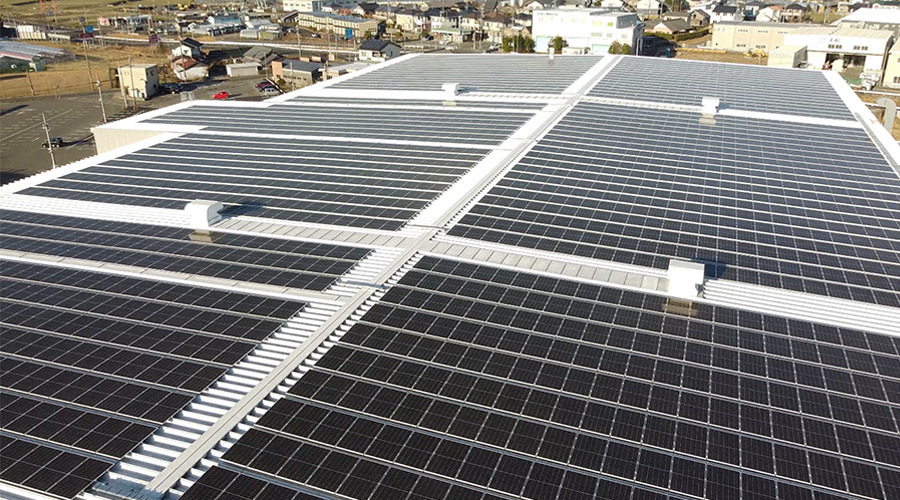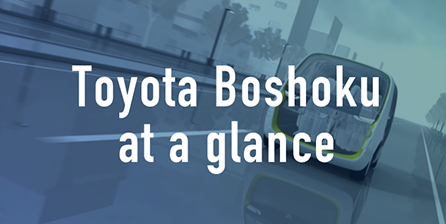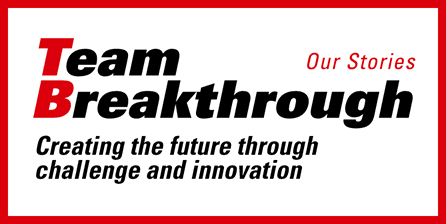GHG Net-zero in the plant*
Basic approach
In pursuit of the GHG Net-zero in the plant, as described in our 2050 Environmental Vision, we are promoting various environmental activities with the aim of reducing GHG emissions by 50% by the year 2030 (compared to FY2020 levels), and reducing GHG emissions by 100% by the year 2035.
- achieving net zero greenhouse gas emissions
Efforts to Achieve Carbon Neutrality
1. Promotion of initiatives to ensure completion of Toyota Boshoku’s 40 initiatives for energy conservation
Energy conservation is important to Toyota Boshoku, with many energy saving initiatives being discussed, shared, and carried out across all areas of our business. However, when looking at the situation on the ground, it’s clear that more still needs to be done in certain areas.
To address this, we have selected 40 specific energy conservation initiatives to be prioritized globally. These initiatives can be divided into two categories: E-JIT* initiatives, which can be implemented through behavioral and workflow changes without additional financial cost, and equipment efficiency improvements, which involve either adoption of highly efficient equipment, or retrofitting of pre-existing facilities.
Additionally, we are working on developing and distributing both a manual for how to approach such improvements, and a mid-term activities plan to guide our future energy savings activities.
- E-JIT: Energy Just-In-Time (generating only the amount of energy that is required at that point in time to produce the necessary quantity of products)
Toyota Boshoku’s 40 items for energy conservation
| Category | Equipment/Machinery | No. | Item |
|---|---|---|---|
| E-JIT | Boilers | 1 | Closing nearby valves in unneeded areas |
| 2 | Regulation of boiler air ratios | ||
| 3 | Periodic steam trap inspections, diagnosis of issues | ||
| 4 | Thorough maintenance to prevent steam leaks | ||
| 5 | Thermal insulation of pipes & valves | ||
| 6 | Removal of unneeded pipes | ||
| Air conditioning | 7 | Periodic cleaning of filters & heat exchange fins | |
| 8 | Consistently turn off when unneeded | ||
| 9 | Use of timers to automatically switch units off | ||
| 10 | Adherence to temperature regulations | ||
| Lighting | 11 | Use of natural lighting (skylights) | |
| 12 | Removal of unneeded lighting | ||
| 13 | Turning off unnecessary/excessive lighting | ||
| 14 | Switching off lighting when unneeded | ||
| Compressors | 15 | Closing nearby valves in unneeded areas | |
| 16 | Thorough maintenance to prevent air leaks | ||
| 17 | Periodic cleaning of filters | ||
| Fans & pumps | 18 | Carrying out periodic cleaning of strainers | |
| 19 | Coupling fans & pumps with production equipment | ||
| Other | 20 | Consistently turn off power outside production times | |
| 21 | Systematically switching off power when not needed |
| Category | Equipment/Machinery | No. | Item |
|---|---|---|---|
| Equipment Efficiency Improvements | Boilers | 22 | Ending use of large-scale boilers in factories |
| 23 | Heat recovery via economizers | ||
| 24 | Installation of boiler control units | ||
| Air conditioning | 25 | Switching to highly efficient air conditioners | |
| 26 | Switching to insulated, heat-reflective glass in equipment buildings | ||
| Lighting | 27 | Switching to LED lighting | |
| Compressors | 28 | Installation of inverter air compressors | |
| 29 | Installation of air tanks | ||
| 30 | Installation of compressor control units | ||
| 31 | Converting to ring main water piping | ||
| 32 | Switching from air cylinders to electric cylinders | ||
| 33 | Converting to electric blowers | ||
| 34 | Converting to highly efficient air blow guns | ||
| Fans & pumps | 35 | Automatic operation of fans & pumps via coolant temperature-sensing inverter control systems | |
| 36 | Reducing water usage by switching pumps to inverter control systems | ||
| 37 | Regulating ventilation by switching fans to inverter control systems | ||
| 38 | Use of highly efficient machinery | ||
| Other | 39 | Heat insulation of hydronics equipment | |
| 40 | Switching to highly efficient, best-in-class transformer models |
2. Active introduction of renewable energy
The Toyota Boshoku group is proactively introducing renewable energy. Since October 2022, 100% of the electricity purchased in Japan from Chubu Electric Power has zero CO2 emissions. Additionally, from January 2023, electricity use at all European sites (excluding sites in Africa) has been successfully converted to 100% renewable energy.
Moving forward, our entire group will continue to systematically introduce renewable energy and respond to the need for carbon neutrality.

Solar power generation equipment installation results
| Before 2019 | 2020 | 2021 | 2022 | 2023 | |
|---|---|---|---|---|---|
| Japan | Kariya Plant Gifu Plant Sanage Plant Takaoka Plant ARACO Toyota Boshoku Kyushu TB Sewtech Kyushu Toyota Boshoku Tohoku TB Logistics TB Technogreen |
Sanage MONOZUKURI Innovation Center | Kariya Plant / Global headquarter Toyohashi-Kita Plant Toyohashi-Minami Plant Toyota Boshoku Shiga |
Tsutsumi Plant | Toyota Boshoku Kyushu (additional) |
| Outside Japan |
China Thailand India |
|
China Thailand Vietnam America Belgium Poland France |
China America |
|
The size of avoided CO2 emissions through the introduction solar power generation equipment

- We calculate the size of avoided CO2 emissions by multiplying the PV power generation which we have introduced by the “CO2 conversion coefficient” of purchased electricity on the below.
Introduction of storage batteries
At our Toyohashi-Kita Plant, we have installed storage batteries to efficiently utilize the electricity generated by the solar generation equipment on the roof. When the generated electricity exceeds immediate consumption, it is stored in the batteries. During peak usage times, the stored electricity is discharged, thereby improving the utilization rate of solar power generation. This approach not only achieves peak shifting but also promotes effective energy use.
Calculation of greenhouse gas emissions
CO2 conversion coefficients for electric power in Japan are calculated with reference to emissions coefficients from each domestic electric utility company (based on emissions survey results), and included in Electric Utility Companies’ Emissions Coefficients (for use in calculating greenhouse gas emissions of companies emitting above a certain set level)-Results from Fiscal 2023, published by Japan’s Ministry of the Environment, whereas for electric power in other regions they are calculated with reference to the IEA’s Emissions Factors 2023.
CO2 conversion coefficients for gas and other fuels are calculated with reference to A Summary of Calculation Methods and Emission Intensities for Systems of Calculating, Reporting and Publishing Environmental Data published by Japan’s Ministry of the Environment.





